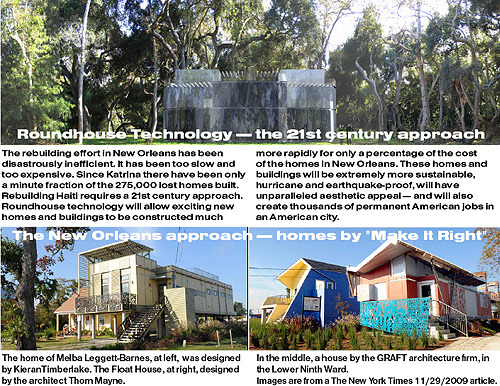Imagine... a solution to what soon will become the most urgent problem facing Haiti -- how to provide safe, permanent housing for more than one million people.
Imagine... doing this in a manner that will greatly benefit the US economy by creating thousands of American jobs, as well as setting the stage to solve this same crucial problem for the rest of the world.
Imagine... building beautiful environmentally advanced communities faster and less expensively than is currently possible.
And now imagine... that all that keeps it from becoming a reality is that the right people don't know it exists.
As billions of dollars will be poured into Haiti's rebuilding, there's absolutely nothing anywhere that comes even close to what this solution offers in every respect!
This is why I embraced the Huffington Post's offer to write about my work and vision for Haiti.
As head of my own New York firm, Eli Attia Architects, and earlier as Chief of Design for Philip Johnson, I designed several internationally-recognized buildings that have been critically acknowledged as instrumental in redefining the modern skyscraper. Among the buildings you may know, are 101 Park Avenue, the Republic National Bank World Headquarters, and the Millennium Hilton Hotel in New York, Pennzoil Place in Houston, 101 California Street in San Francisco, the Shalom (Azrieli) Center in Tel Aviv, and the Crystal Cathedral in Orange County.
I suspended my practice more than five years ago to devote all my time to creating sustainable technologies that will produce better quality, environmentally-responsible buildings faster and less expensively. One result is the Roundhouse Technology (RHT). It uses a ground-up approach to improve every aspect of the production of buildings, ranging in size from a small single family homes to large apartment buildings, as well as medium size commercial buildings and community centers. It is a scalable solution to build buildings that can be adapted to nearly any terrain, any climate, in endless variety of building forms.
While the world has long needed dramatic improvement in the way buildings are built (more about it in future blogs), the disaster in Haiti makes it so much more urgent. As we have seen in New Orleans, the traditional way of building new homes doesn't work in these situations. It's much too slow and much too costly.

The outstanding benefits of RHT -- listed below -- are ideal for addressing the rebuilding that Haiti's overwhelming devastation mandates.
While RHT is based on proven technology -- which has been in use for much of the last century in building large commercial structures the world over -- it is the first time ever where this technology will be applied to all forms of dwelling, and will set the model that can be repeated anywhere in the world. It will also combine -- for the first time ever -- advanced manufacturing processes AND uniqueness of appearance -- prerequisite for viable urban fabrics of cities.
RHT is fully developed and is ready for immediate implementation.
The following captures, more specifically, the essence of RHT as it applies to Haiti:•Much faster and less costly to build;•Earthquake-proof; •Hurricane-proof; •Unparalleled sustainability: Minimized carbon footprint, materials use, and waste created during construction; •Minimized energy required to operate;•Natural climate control;•Repurpose content quickly and inexpensively as is often required;•Durable and of low life-cycle cost;•Non combustible;•No deforestation required;•Unparalleled urban richness, aesthetic appeal, and user experience;and,•Will be manufactured fast here -- creating thousands of permanent American jobs in American cities -- and assembled fast there by easily acquired skills (at a later point manufacturing could be transferred to Haiti).
These are powerful incentives and drivers for adoption of this technology.
In moments of urgent needs, visionary leaders have made the leap into the next level of breakthrough solutions to crucial problems. Like President Roosevelt, who embraced a whole new technology to create the Liberty Ships in WWll, world leaders should embrace RHT for Haiti.
We can help rebuild Haiti, allowing Port-au-Prince to be an example for the future -- as the new environmentally-sound city rises -- and do it while strengthening our economy at home and setting a standard for building exciting, affordable communities around the world.